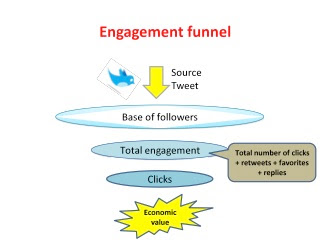The Value of a Twitter Follower

by Puja Ramani and Sampada Telang What we learned from applying the life time value analysis as well as engagement funnel analysis techniques for Twitter. (Note: if the graphics below are difficult to read, you can download a PDF version of this post here ). Our goal was to estimate the value of a Twitter follower for various publishers on Twitter. ‘Publisher’ refers to any entity with a business objective on Twitter (examples: Amazon, TechCrunch, celebrities or even local businesses). Given that Twitter primarily earns its revenues by charging publishers (via promoted tweets) as opposed to individual profile owners, we will refer to Twitter’s publishers as its ‘customers’. Our focus was applying the tool not to Twitter’s customers (i.e., publishers) directly, but to Twitter’s customers’ customers (i.e., publishers' followers) in an attempt to quantify how much value Twitter was creating for publishers. We studied a very small set of publishers, so these findings shouldn’t ...



